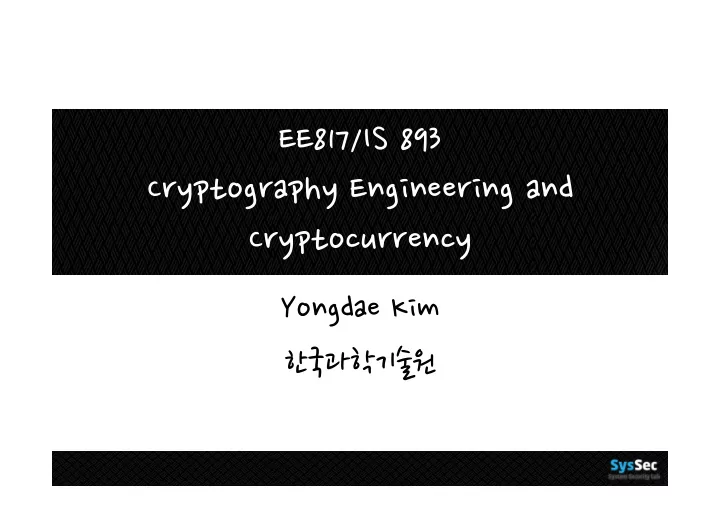

EE817/IS�893� Cryptography�Engineering�and� Cryptocurrency� Yongdae�Kim� 한국과학기술원 �
Definition� q A� hash�function �is�a�function�h� ▹ compression� —�h�maps�an�input�x�of�arbitrary�finite�bitlength,�to�an� output�h(x)�of�fixed�bitlength�n.� ▹ ease�of�computation� —�h(x)�is�easy�to�compute�for�given�x�and�h� q preimage�resistance�=�one-way� ▹ it�is�computationally�infeasible�to�find�any�input�which�hashes�to�that�output� q 2nd-preimage�resistance�=�weak�collision�resistance� ▹ it�is�computationally�infeasible�to�find�any�second�input�which�has�the�same�output�as� any�specified�input� q collision�resistance�=�strong�collision�resistance� ▹ it�is�computationally�infeasible�to�find�any�two�distinct�inputs�x,�x’�which�hash�to�the� same�output�
Merkle-Damgard�scheme� q The�most�popular�and�straightforward� method�for�combining�compression� functions�
Strengthened�Merkle-Damgard�
Collision�resistance� q If�the�compression�function�is�collision� resistant,�then�strengthened�Merkle-Damgard� hash�function�is�also�collision�resistant� q Collision�of�compression�function:� f(s,�x)=f(s’,�x’)�but�(s,�x)≠(s’,�x’)�
Collision�resistance� q If�h(,)�is�collision� resistant,�and�if� H(M)=H(N),�then� len(M)�should�be� len(N),�and�the�last� blocks�should�coincide�
Collision�resistance�
Collision�resistance� q And�the�penultimate� blocks�should�agree,� and,�
Collision�resistance� q And�the�ones�before� the�penultimate,� too...� q So�in�fact�M=N�
Extension�property� q For�a�Merkle-Damgard�hash�function,� H(x,�y)�=�h(H(x),y)� ▹ Even�if�you�don’t�know�x,�if�you�know�H(x),�you�can� compute�H(x,�y)� ▹ H(x,�y)�and�H(x)�are� related �by�the�formula� ▹ Would�this�be�possible�if�H()�was�a�random�function?�
Fixing�Merkle-Damgard� q Merkle-Damgard:�historically�important,�still� relevant,�but�likely�will�not�be�used�in�the�future� (like�in�SHA-3)� q Clearly�distinguishable�from�a�random�oracle� q How�to�fix�it?��Simple:�do�something�completely� different�in�the�end�
SMD�
EMD� q IV 1 ≠IV 2�
MDP� q π:�a�permutation�with�few�fixed�points� ▹ For�example,�π(x)=x⊕C�for�some�C≠0�
Hash�Chain� q h:�Cryptographically�strong�hash�function� q H 0 =�x� q H n =h(H n-1 )�=�h(h(h(…�h(x))))� q Random�mapping�statistics� 14
One�time�password� q Setup� ▹ User�generates�H 0 ,�H 1 ,�…�H n .� ▹ User� à �Server:�H n� ▹ Server�stores�H n� as�the�user’s�public�password.� q Authentication� ▹ At�time�0:�User� à Server:�H n-1� ▹ Server�verifies�h(H n-1 )�=�H n � ▹ Server�stored�H n-1� as�the�user’s�public�password.� ▹ At�time�1:�User� à �Server:�H n-2� ▹ …�
Hash�Tree� H i �=�h�(�H 2i ,�H 2i+1 )� H 1 � H 2 � H 3 � H 4 � H 5 � H 6 � H 7 � H 8 � H 9 � H 10 � H 11 � H 12 � H 13 � H 14 � H 15 � B 1 � B 2 � B 3 � B 4 � B 5 � B 6 � B 7 � B 8 �
MAC�&�AE�
MAC� q Message�Authentication�Code� q ‘keyed�hash�function’�H k (x)� ▹ k:�secret�key,�x:�message�of�any�length,�� H k (x):�fixed�length�(say,�128�bits)� ▹ deterministic� q Purpose:�to�‘prove’�to�someone�who�has�the�secret� key�k,�that�x�is�written�by�someone�who�also�has� the�secret�key�k� 18
How�to�use?� q A�&�B�share�a�secret�key�k� q A�sends�the�message�x�and�the�MAC�M←H k (x)� q B�receives�x�and�M�from�A� q B�computes�H k (x)�with�received�M� q B�checks�if�M=H k (x)�
Attack�scenario� q E�may�eavesdrop�many�communications�(x,�M)� between�A�&�B� q E�then�tries�(possibly�many�times)�to�‘forge’�(x’,� M’)�so�that�B�accepts:�M’=H k (x’)� q Question:�what�if�E�‘replays’�old�transmission�(x,� M)?��Is�this�a�successful�forgery?�
Capabilities�of�attackers� q Known-text�attack� ▹ Simple�eavesdropping� q Chosen-text�attack� ▹ Attacker�influences�Alice’s�messages� q Adaptive�chosen-text�attack� ▹ Attacker�adaptively�influences�Alice�
Types�of�forgery� q Universal�forgery:�attacker�can�forge�a�MAC�for� any �message� q Selective�forgery:�attacker�can�forge�a�MAC�for�a� message�chosen�before�the�attack� q Existential�forgery:�attacker�can�forge�some� message�x�but�in�general�cannot�choose�x�as�he� wishes�
Security�of�MAC� q Should�be�secure�against�adaptively�chosen- message�existential�forger� ▹ Attacker�may�watch�many�pairs�(x,�H k (x))� ▹ May�even�try�x�of�his�choice� ▹ May�try�many�verification�attempts�(x,�M)� ▹ Still�shouldn’t�be�able�to�forge�a�new�message�at�all�
Two�easy�attacks� q Exhaustive�key�search� ▹ Given�one�pair�(x,�M),�try�different�keys�until� M=Hk(x)� ▹ Lesson:�key�size�should�be�large�enough� q Pure�guessing:�try�many�different�M�with�a�fixed� message�x� ▹ Lesson:�MAC�length�should�be�also�large� q Question:�which�one�is�more�serious?� 24
Random�function�as�MAC� q Suppose�A�and�B�share�a�random�function�R(x),� which�assigns�random�128-bit�value�to�its�input�x� q Even�if�E�sees�many�messages�of�form�(x,�R(x)),� for�a� new �y,�R(y)�can�be�any�of�2 128 �strings� q Successful�forgery�prob.�≤�2 -128�
Random�function�as�MAC� q It�is�a�perfect�MAC,�but�the�‘key�size’�is�too� large:�how�many�functions�of�form� R:�{0,1} m →{0,1} n ?�Answer:�2^(n�2 m )� q But�there�are�keyed�functions�which�are� ‘indistinguishable’�from�random�functions:�called� PRFs�(PseudoRandom�Functions)� q Designing�a�secure�PRF�is�a�good�way�to�design�a� secure�MAC�
Truncation�of�MAC� q H k (x)�is�a�secure�MAC�with�256-bit�output� q H’ k (x)�=�the�first�128�bits�of�H k (x)� q Question:�is�H’ k (x)�a�secure�MAC?�� • Answer:�not�in�general,�but�secure�if�H k (x)�is�a�secure�PRF� 27
Practical�constructions� q Blockcipher�based�MACs� ▹ CBC-MAC� ▹ CMAC� q Hash�function�based�MACs� ▹ secret�prefix,�secret�suffix,�envelop� ▹ HMAC�
CBC-MAC� q CBC,�with�some�fixed�IV.��Last�‘ciphertext’�is�the�MAC� q Block�ciphers�are�already�PRFs.��CBC-MAC�is�just�a�way�to�combine� them� q Secure�as�PRF,�if�message�length�is�fixed�
CBC-MAC� q Secure�as�PRF,�if�message�length�is�fixed� q Completely�insecure�if�the�length�is�variable!!!�
CBC-MAC� q ‘Extension�property’�once�more!� q How�to�fix�it?� ▹ Again,�do�something�different�at�the�end� to�break�the�chain�
Modification�1� ▹ Use�a�different�key�at�the�end� ▹ Good:�this�solves�the�problem� ▹ Bad:�switching�block�cipher�key�is�bad�
Modification�2� ▹ XORing�a�different�key�at�the�input�is� indistinguishable�from�switching�the�block�cipher� key�
CMAC� q NIST�standard�(2005)� q Solves�two�shortcomings�of�CBC-MAC� ▹ variable�length�support� ▹ message�length�doesn’t�have�to�be�multiple�of�the� blockcipher�size�
Some�Hash-based�MACs� q Secret�prefix�method:�H k (x)=H(k,�x)� q Secret�suffix�method:�H k (x)=H(x,�k)� q Envelope�method�with�padding:�� H k (x)=H(k,�p,�x,�k)�
Secret�prefix�method� q Secret�prefix�method:�H k (x)=H(k,�x)� ▹ Secure�if�H�is�a�random�function� ▹ Insecure�if�H�is�a�Merkle-Damgard�hash�function� » H k (x,�y)=h(H(k,�x),�y)=h(H k (x),�y)�
Secret�suffix�method� q Secret�suffix�method:�H k (x)=H(x,�k)� ▹ Much�securer�than�secret�prefix,�even�if�H�is� Merkle-Damgard� ▹ An�attack�of�complexity�2 n/2 �exists:� » Assume�that�H�is�Merkle-Damgard� » Find�hash�collision�H(x)=H(y)� » H k (x)�=�h(H(x),�k)�=�h(H(y),�k)�=�H k (y)� » off-line! � 37
Recommend
More recommend